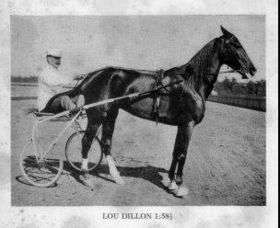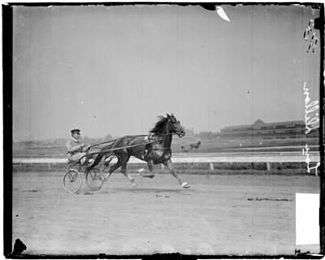C.K.G. Billings

Cornelius Kingsley Garrison Billings (September 17, 1861 in Saratoga, New York – May 6, 1937 in Santa Barbara, California) was a wealthy industrialist, a noted horseman and tycoon. When he retired in 1901 at age 40 he was president of the Peoples Gas Light and Coke Company in Chicago, Illinois.
A notable eccentric, Billings invested much of his time and money promoting the sport of matinee driving (trotting), a sport that is still popular today in the United States.
Life and career
Billings grew up in Chicago, where his entrepreneurial father was a principal in the Peoples Gas Light and Coke Company during the time when Chicago was largely lit by gaslight. After college he joined his father’s firm, eventually inheriting controlling interest in the company and, at the age of 40, retired from business to devote his time to his growing stable of horses.[1] In 1901 he moved his family and his horses to New York City, and acquired acreage on the largely undeveloped north end of Manhattan. It was near the newly opened and very fashionable Harlem Speedway, an exclusive dirt track along the Harlem River between 155th and Dyckman Streets.

Dinner on horseback
On March 28, 1903, Billings, who had recently opened a private 25,000-square-foot (2,300 m2), $200,000 trotting stable near 196th Street in what is now Fort Tryon Park, was going to celebrate the opening by hosting an exclusive dinner at the stable, catered by fashionable restaurateur Louis Sherry. Word leaked out however, and crowds of reporters gathered by his gates, hoping to see the fabulous stable and glamorous visitors. Billings decided to quietly move the party, and instead rented the grand ballroom of Sherry's, at Fifth Avenue and 44th Street. He had the floor covered with turf so that he and his 36 guests could sit on their horses, (which had been taken up to the fourth-floor ballroom by elevator) while having dinner. The diners ate from trays attached to their saddles and sipped champagne through rubber tubes from iced bottles in their saddlebags.[2][3] The $50,000 bill included a photographer from the celebrated Byron Company to document the event.
Estates
Tryon Hall
By 1907, the mansion, called Tryon Hall, was complete, and Billings, his wife Blanche E. MacLeish Billings, two children and 23 servants had moved into the massive chateau, now their full-time residence, located to the west of the stables, on a promontory 250 feet (76 m) above the Hudson River.

Described at the time as "In the style of Louis XIV", the house, designed by Guy Lowell,[4] had several large towers, a Mansard roof along with a 75-foot (23 m) marble swimming pool, squash courts and bowling alleys. The cost was $2,000,000, and it was generally considered among the most lavish private houses in Manhattan.[5] It had towers and turrets, conical steeples, oriel windows, and vast expanses of shingled roof. It stood on Manhattan's highest point, 250 feet (76 m) above sea level, with 20-mile (32 km) views of the Hudson Valley. His 25-acre (10 ha) estate encompassed formal gardens, a 126-foot-long (38 m) bathhouse with a 75-foot (23 m) indoor pool, and a yacht landing on the Hudson at Dyckman Street. There he kept his 232-foot (71 m) yacht, Vanadis. Billings then hired the architects Buchman & Fox to design an extravagant entry to his estate. They laid out the inclined roadway and a great arched stone loggia to carry a terrace above. Most of the stone was quarried right on the site and the surface of the roadway was paved with chamfered bricks. The total cost of Billings’ new driveway was $250,000. The arched gallery, supporting a planted terrace overlooking the Hudson in Fort Tryon Park, still remains, though the driveway entrance, now from the Henry Hudson Parkway is long disused.
By 1916 Billings had tired of this location, and by early 1917 sold the whole operation to John D. Rockefeller, Jr. for $35,000 per acre.[4] Rockefeller intended to tear down Tryon Hall initially and give the land to the city for a new park. Inwood and Washington Heights was in need of a park in the neighborhood, Architects protested destruction of the house and the city turned down the offer of a new park. The mansion was rented out. Tryon Hall burned in a spectacular fire in 1925,[4] and the city finally accepted Rockefeller’s gift of the new 67-acre (27 ha) Fort Tryon Park, which opened in 1935. All that remains today of the estate is the old gatehouse near the park entrance and its famous driveway which features the "Billings Arcade" of 50 foot tall Maine granite archways.[4]
Farnsworth
After leaving Tryon Hall, Billings moved to another grand estate he had built, this one called "Farnsworth" and located in Locust Valley, New York, on Long Island. It was again designed by Guy Lowell, this time in the Georgian Revival style, with the landscaping of the extensive grounds designed by Andrew Robeson Sargent of Boston. The buildings alone on the estate cost $1,550,000 in 1915. Although Georgian in style, Lowell designed it to be similar to an Italian villa, in that the mansion was built around a patio at its center. The house featured 11 master bedrooms with 9 baths, and 19 servants bedrooms with 4 baths. The appointments were expensive and luxurious.[6]
Despite the grandeur of the surrounding, Billings did not stay put in Farnsworth any longer than he had in Tryon Hall. With World War 1 raging, Farnsworth began to sell off his East Coast properties. He traded Farnsworth for the now demolished Johnson Building in New York City, and sent his furniture to Santa Barbara, California. Temporarily, the mansion became a military hospital, and the estate then passed on to other owners.[6]

Horses
Billings owned some of the nation's finest trotters and pacers, one of which, Lou Dillon, was the first to trot a two-minute mile. In May 1903 Billings spent $12,500 at a dispersal sale in Cleveland for the mare and added her to his stable of matinee horses with the hopes that she could bring him a victory in the next Memphis race. His investment paid off, as she became a phenomenal horse that captured the attention of the nation. By this time Billings was regarded as a "Grand Marshal" of matinee racing.[7] In 1905, however, he sold his stable at Madison Square Garden, stating that he proposed to go abroad for a few years.[8]
Later life
Billings moved to Santa Barbara, California in 1917 to more fully indulge his love of fast horses.
Legacy
- The Billings estate and mansion has been immortalized in the Philo Vance mystery The Dragon Murder Case by S. S. Van Dine.[4]
- Billings' yacht Vanadis is now anchored at Riddarholmen in Stockholm, and is used as a hotel known as Mälardrottningen with the ship rechristened as Lady Hutton.[9][10][11]
- The CKG Billings Amateur Driving Series, a much recognized amateur American sporting event, as of 2010.[12][13]
See also
References
Notes
- ↑ Renner, James, C.K.G. Billings May 2003, Washington-Heights.us
- ↑ Pollak, Michael, FYI August 2004, NYTimes.com archive
- ↑ Bryk, William, Banquet on Horseback March 2005, NYSun.com
- 1 2 3 4 5 Renner, James. Washington Heights, Inwood, and Marble Hill. Portsmouth, New Hampshire: Arcadia Publishing, 2007. p.20. ISBN 0-7385-5478-2
- ↑ A contemporary rival was the Charles M. Schwab House, "Riverside", on the Upper West Side.
- 1 2 "'Farnsworth' The Long Island Home of C. K. G. Billings, Esq., at Locust Valley — A Country Estate in Every Respect Perfectly Appointed on The Country House website (September 27, 2013)
- ↑ The Rise, Decline and Fall(?) of Matinee Racing Western Reserve Matinee Club
- ↑ Archive CKG Billings Hoses sold for Big Prices November 1905, The New York Times
- ↑ Hammond, Margo (November 23, 1988). "All Aboard: Luxury Yacht Rocks Gently at Stockholm Harbor" (PDF). The Milwaukee Journal. pp. 33, 35. Retrieved December 13, 2014.
- ↑ Snow, Brook Hill (March 15, 1987). "Off The Beaten Path The Lady Hutton, One Of The World's Largest Luxury Yachts, Is Now An Elegant Hotel In Downtown Stockholm". Sun Sentinel. Stockholm, Sweden. Retrieved 18 October 2014.
- ↑ Vanadis to Lady Hutton, Kajsa Karlsson, (1987)
- ↑ Corban, Anthony, CKG Billings Review August 2003, harnesslink.com
- ↑ Knox, Tammy, Billings Amateur Trot makes stop at Hoosier Park May 2010, ustrotting.com
External links
| Wikimedia Commons has media related to C. K. G. Billings. |
- Works by or about C.K.G. Billings at Internet Archive
- CKG Billings Estate. Slideshow.